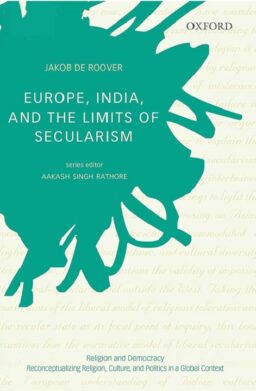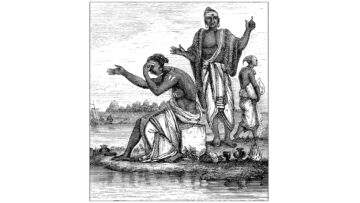Introduction
Ever since Indian independence, debates among intellectuals and political commentators regarding the role of secularism in Indian politics has raged on without any solution in sight. These debates have been accompanied by an intensification of conflicts between the Hindus (the so called majority religious community of India) and the Muslims. The secularists argue that India needs secularism, and fear that if the state takes the side of the Hindu majority during conflicts it would no longer be an impartial arbiter. The anti secularists on the other hand claim that the current Indian state is in fact a pseudo-secular state whose policies and laws consistently favour Muslims and Christians over the Hindus. With the advent of social media, these debates have degenerated further into emotion tinged barbs and mudslinging rather than well reasoned arguments and disciplined thinking.
Professor Jakob De Roover’s book Europe, India, and the Limits of Secularism brings some much reasoned light in midst of the emotional heat generated by these debates. Rather than blaming the Indian state for incorrectly or improperly applying the principles of secularism, De Roover suggests that the failure of secularism in India is to be blamed on the cognitive limits of the liberal secular model itself. This model was developed within a specific cultural context, namely modern Europe, and is underpinned by certain assumptions about human beings and religion. These assumptions, while being part of the cultural common sense of Europe, doesn’t make sense to non-Western cultures, including the Indian one.
In the introduction of his book, Professor De Roover makes clear the goal of his book: To examine the cultural constraints of the model of liberal secularism developed in Europe, which also determined the European understanding of Indian culture. The succeeding chapters of the book identify the cultural constraints common to the liberal secular model by tracing its development within Europe, as well as its application in India.
The Difficulty of the Two Spheres
Chapter one, ‘Limits of Liberal Secularism’, discusses at length about the difficulty in separating the sphere of politics from the private sphere of religion. De Roover takes the examples of the hijab and the crucifix. Secularism entails that public institutions be free of religious symbols, but in order for that to happen, the states need to decide which symbols count as religious symbols. How do European courts and other institutions determine whether or not the hijab and the cross are religious symbols? It is Christian and Islamic theology that transforms the hijab and cross into religious symbols. These examples serve to illustrate that it is impossible for state institutions to determine from a neutral perspective when some object is a religious symbol. It has to accept the premises of some or another theology that transforms certain objects into religious symbols. The second half of the first chapter moves on to the problem of demarcating religion from politics in India where the problem is even more acute. Professor De Roover picks out examples from the Indian constituent assembly debates as well as court cases which clearly demonstrate that Indian government officials could not even make up their mind about the basic foundational question of what liberal secularism consists of, much less the separation of the political sphere from the religious sphere. One of the representatives in the constituent assembly debates commented that the idea of a common law being observed by all citizens of a secular state, in all matters, is a very strange idea. However, the idea that the same set of laws apply to all citizens, irrespective of their religious affiliation, is a central principle of the liberal secular state. De Roover brings up the example of the important Shirur Mutt case of 1954 in which the Supreme Court struggled to define what constituted Hindu religion and what does not. The Shirur Mutt case demonstrates the difficulty in defining the term Hinduism, since it encompasses ‘’a range of traditions, all of which prefer different narratives, draw on different teachers, and emphasize different texts and customs’’[1].
The Emergence of Liberal Secularism: Two Accounts.
In chapter two, ‘Stories of Liberal Secularism’, Jakob De Roover contrasts the classical account of the emergence of the liberal secular state within Europe, with the alternative account provided by the research program he is working under, the Comparative Science of Cultures started by professor S.N. Balagangadhara of Ghent University. De Roover does a comprehensive analysis of the writings of various European scholars through the centuries in order to draw out the common set of assumptions they share about their own culture and other cultures, as well as the emergence of religious toleration in Europe. The result of this analysis shows that the Western self understanding as well as their understanding of other cultures transforms non-Western cultures into pale and erring variants of the Western culture. The basic structure of every culture becomes identical under this framework. Only the content varies. Europe has Christianity, India has Hinduism. Europeans believe in one God, the Hindus believe in many gods and so on and so forth. Thus, they presuppose that all plural societies face a similar problem, namely that they are composed of followers of different religions. Each of these religions have competing, conflicting doctrines, and it is up to society to find a way for these different religious communities to coexist. According to this story, until the liberal model of toleration came along, intolerance was the norm among society. However, this account ignores the history of many non Western societies including the Indian one, where followers of various religions and traditions lived side by side with minimal conflict.
Contrasted against the classical account of Western society and the development of liberal toleration is the account provided by Professor Balagangadhara’s research program. The heuristic utilized by this program is that it studies Western culture against the backdrop of Indian culture, attempting to provide insights into both cultures in the process. Balagangadhara claims that the modern West, far from being a secular culture, is steeped in and was born out religion, specifically Christianity. In contrast, Asian cultures are cultures without religion[2]. One of the strengths of Balagangadhara’s theory of religion is that it is able to show how many of the ideas about politics, religion, and human psychology that we think of as self evident and universal, emerged from within the framework of Christianity. Jakob De Roover provides the example of the concept of sovereignty that is central to modern political theory. Christian ideas about God as the sovereign gave rise to the concept of the king as the sovereign, deriving his sovereignty from God. Gradually, the theological idea of the sovereign became secularized and allowed us to talk about national and even individual sovereignty. The other strength of Balagangadhara’s theory is that it explains how the structure of religion necessitates religious ideas being reproduced in a secular guise. This structure produces a double dynamic, whereby religion spreads and universalizes itself in two ways: proselytization and secularization. Proselytization is the well known and familiar dynamic through which religion spreads. Secularization is the gradual process through which theological ideas become so commonplace in a society, they are no longer seen as religious. The rest of the book sees Jakob De Roover develop his account about the emergence of liberal secularism in both Europe and India within the ambit of Balagangadhara’s research program, specifically utilizing the idea of secularization as a conceptual heuristic to build his hypothesis.
Conceptual roots of Liberal Secularism
The next three chapters (three, four, and five) sees Jakob De Roover systematically and convincingly trace the origin and development of certain ideas that became the building blocks of liberal secularism, by traveling far back into the history of Western Christianity, specifically the Protestant Reformation. De Roover formulates the hypothesis that the conceptual foundation of liberal secularism lies in two theological doctrines: The doctrine of the two kingdoms and Christian liberty. The distinction between the spiritual kingdom and the earthly kingdom has been part and parcel of Christianity since its inception. The spiritual kingdom is outside of our world and it is where God resides. In medieval Europe, the monarch or king was recognized as the ruler of the earthly kingdom, while the Church had absolute authority on religious matters and created a body of laws and doctrines related to those matters that the subjects were obligated to obey[3]. The Protestants also adopted the theology of the two kingdoms but with modifications. Protestant theology divides human existence into the political kingdom, where man must obey the secular authorities, and the spiritual kingdom where God alone rules. It is through faith alone, in God’s word (his revelation and teachings), that the believer attains salvation. It is God alone that grants salvation. Thus, matters of faith and belief are between the individual believer and God alone. Since it is God alone that rules the spiritual realm, the believers ought to be free from human interference in the spiritual realm. Christian freedom means human laws and institutions cannot rule over the soul. Protestant theology drew the boundary between true religion and idolatry along the lines of essentials commanded by God in Scripture as opposed to manmade laws and doctrines falsely imposed as religion. Using the political theology of the two kingdoms and Christian liberty, the Protestant reformers challenged the authority of the Church. They accused the Church of oppressing Christian liberty by prescribing manmade laws as though they were spiritual laws. The institution of the Church, including its doctrines and laws, were rejected as idolatry because human works were presented as necessary for the soul’s salvation[4].
Jakob De Roover’s exposition of the political theology of the two kingdoms shows a striking structural similarity between this theology and the liberal secular model which also divides society into two spheres: The public political sphere, and the private sphere of religious belief. De Roover does a commendable job of detailing the secularization of the theological concept of the two kingdoms from the Reformation all the way to the Enlightenment period of European history, through a focused historical analysis. He concludes that the liberal model of secularism is built upon secularized theological ideas such as religion being universal, and religion and politics are two distinct spheres of existence. Even though liberal secularism is commonly presented as a neutral, universally applicable political model, the ideas that serve as its building blocks are grounded in a Christian theological framework. De Roover points out that one of the consequences of the liberal secular model being grounded in Christian theology is that it would cease to be intelligible and accessible in non Western, non Christian cultures.
The Implementation of the Liberal Model of Toleration Within India
Chapters six and seven sees Jakob De Roover test this hypothesis through the real world experiment of introducing and implementing the liberal secular model that occurred within India. Chapter six, ‘Religious Toleration in British India’, deals with the implementation of the liberal model of toleration within British India, and its impact on the Hindu traditions. De Roover raises and answers two important questions in this chapter: Why did the British administrators and officials not only argue that Hindu practices should be tolerated, but also integrated Hindu law into colonial jurisdiction? After all, the British colonials were Protestants. They saw Hindu practices as false religion that violated both divine and natural law. And yet, they argued that Hindu practices should be tolerated. As we shall see, the very same Protestant theological framework that structured the British colonials’ experience of Hindu traditions as false religion, also gave birth to a normative ethical framework, the framework of Christian liberty, that placed a moral obligation on the colonial state to tolerate Hindu practices[5]. The second important question Jakob De Roover raises is, how did the colonial state’s implementation of the liberal model of toleration impact the Hindu traditions?
Professor De Roover does a thorough analysis of the relevant literature in order to answer these two questions, including the writings of nineteenth century British colonial officials, official colonial court and government records, and the writings of Hindu intellectuals and reformers. First, De Roover addresses the dominant explanation of why the British government tolerated Hindu practices, namely out of political expediency in order to prevent rebellion in their territory. De Roover points out that although political expediency played a role, it does not explain why colonial officials argued for religious toleration as an unconditional moral obligation for the colonial state. The fact that the British searched feverishly for scriptural sanctions for Hindu practices, in order to verify that these are indeed religious practices, shows that it wasn’t merely political expediency that drove religious toleration. There was a normative framework that compelled the British to adopt toleration as a moral obligation. The author uses examples of the British Raj’s policies towards practices such as sati and human sacrifice as evidence of the presence of this normative framework.
There was a long protracted debate among the colonial administrators, missionaries, and orientalists on whether or not sati should be tolerated. The question of whether or not the practice of sati should be tolerated hinged on whether or not sati was a religious practice. The manner in which colonial administrators determined whether or not sati was a religious practice was by searching for scriptural sanctions for the practice. Brahmin pundits were consulted as to whether or not the immolation of a widow alongside the corpse of her husband was prescribed by the Shastras. Similar debates ensued about practices such as female infanticide and the offering of human sacrifices to the Ganges. It was decided that the practice of offering the aged and infirm to the Ganges should be allowed because it was sanctioned by the Hindu sacred texts, whereas female infanticide was banned as murder because it did not have the sanction of any Hindu religious text.
These examples show that prudence and political expedience alone fail to explain the toleration policy, because that would mean that any and every practice of the Hindus should have been tolerated. The British administrators were operating in a systematic way when it came to picking and choosing which traditions to tolerate. Traditions which they found to have scriptural sanction were tolerated. Once Jakob De Roover establishes that the British toleration of Hindu practices was based on systematic normative reasoning rather than prudential considerations, he raises the logical question that follows from this premise: Why did the British try to find ‘ancient religious texts’ and seek justification for controversial practices there? De Roover locates the answer to this question within the Christian, and specifically Protestant religious framework. This Christian religious framework sees all human souls as being created by God with the inclination to obey and worship God being embedded within them. However, the devil and his priests corrupt this inclination by imposing their fabrications as divinely revealed commandments on naïve believers. The history of humanity up till the coming of Jesus Christ was the history of false religion[6]. The various traditions the British encountered in India were experienced through the lens of this Christian theological framework. They were all part and parcel of an idolatrous or false religion. In order to understand such a religion and the people that followed such a religion, one had to understand the texts that the Hindus (wrongly) believed to be God’s revelation.
The notion that any practice that is found to be sanctioned by the so called Hindu scriptures, ought to be tolerated is derived from a Protestant theological framework. Christian liberty and its model of the two kingdoms are the doctrines that become the foundation for the normative model of toleration. It is God’s will that every individual should be free to follow whatever he or she believes to be God’s word or revelation. Relying on the writings of various colonial officials, Jakob De Roover outlines the gradual transformation of the texts such as the Sastras into a systematic and uniform body of sacred law by the colonial officials. Traditionally, texts such as the Dharmasastras had not been codes of law but a set of heuristics, reflections and sayings that described the traditions as well as the dispute settling mechanisms of different groups. The toleration policy compelled colonial officials to determine which practices were truly religious by finding legal sanction in the so called law books of the Hindus. The Protestant conceptual structure which divided religious practices into those sanctioned by God in scripture, and human creations falsely imposed as religion, became transplanted onto the Hindu traditions. Colonial officials began to look for a consistent set of Hindu doctrines and laws which would serve as the foundation for the so called Hindu religion. Any traditions which the British officials found objectionable and not found in texts such as the Sastras were denounced and banned as not being part of the Hindu religion. In this way, the concept of false religion/idolatry became secularized and became part of British colonial law, in order to determine which practices were truly Hindu. But since texts such as the Dharmasastras did not function as a consistent set of doctrines or laws, the colonial officials ran into many problems when trying to codify them in such a manner. The author provides the example of Governor Elphinstone of Bombay Presidency who described the Dharmasastras as a collection of ancient treatises that were unclear and inconsistent, whose content no one really knew. He found that most of the communities in India followed traditions that were underived from any text. The pundits the colonial government relied upon to interpret these texts with regard to legal matters could come to ‘’any decision by quoting from a variety of books with the same book having a variety of decisions on the same question’’[7].
De Roover discusses the tragic consequences of the colonial model of toleration in post colonial India. This Protestant theological framework revolving around the notions of true and false religion would continue shaping legal reasoning about Hinduism well past independence. Supreme Court judges developed the concept of ‘essential’ religious practices; i.e. those that are mentioned or sanctioned in the so called Hindu texts. Other practices were rejected as unessential and not part of Hinduism. Thus, judges obtained the authority to determine which practices of the Indian traditions were essentially religious based on the Christian theological distinction between true and false religion. This situation in India is made even more tragic by the fact that unlike the British officials, the Indian judges do not understand the Protestant theological framework which undergirds the Indian legal system. When it came to the British officials, they came from a culture shaped by centuries of Christian, and specifically Protestant theology. The Protestant theological framework was always in the background, guiding them in their legal reasoning and decision making. In the case of the Indian judges and politicians, the lack of this shared theological framework made their legal determination about the essentiality or inessentiality of a particular practice completely arbitrary.
(……..to be continued)
[1]ROOVER, Jakob de. Europe, India, and the limits of secularism. New Delhi, India: Oxford University Press, 2015, p. 41.
[2]S.N. Balagangadhara’s theory of religion is expounded in detail in his book, The Heathen in his Blindness: Asia, the West, and the Dynamic of Religion.
[3] The practical reality of medieval Europe was much messier. The authority of the king and Church would often clash and eventually led to the infamous Papal revolution.
[4] Christians believe that the cosmos is governed by God’s Revelation in Christianity is a specific theological term which means God’s plan o
[5] A normative ethical framework is one which makes actions obligatory or forbidden for all people at all times. normative ethical sentences contain the moral ‘ought’ e.g. ‘you ought not to kill’’ which makes something either obligatory or forbidden. The Semitic religions (Christianity, Islam, and Judaism) are all built around a normative ethical framework, which is universal in nature. According to S.N. Balagangadhara’s research, this normative ethical framework is absent in Indian culture.
[6]The sole exception being the Jews
[7]ROOVER, Jakob de. Europe, India, and the limits of secularism, p. 189.
Disclaimer: The opinions expressed in this article belong to the author. Indic Today is neither responsible nor liable for the accuracy, completeness, suitability, or validity of any information in the article.










